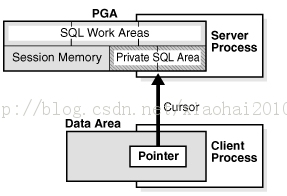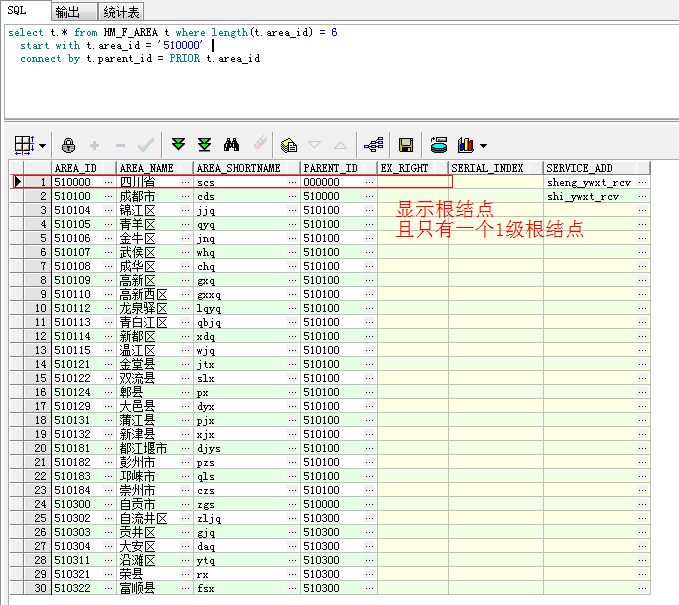【Oracle】-【show_space和show_space_asm】-执行存储过程show_space和show_space_asm报错问题
【Oracle】-【show_space和show_space_asm】-执行存储过程show_space和show_space_asm报错问题
Sys建立show_space()和show_space_asm()。
Bisal执行提示:
SQL> exec show_space('MY_OBJECTS', 'BISAL');
BEGIN show_space('MY_OBJECTS', 'BISAL'); END;
*
ERROR at line 1:
ORA-06550: line 1, column 7:
PLS-00201: identifier 'SHOW_SPACE' must be declared
ORA-06550: line 1, column 7:
PL/SQL: Statement ignored
Sys用户执行:
grant execute on show_space to bisal,bisal还是无法执行。
Sys用户执行:
SQL> create public synonym show_space for sys.show_space; Synonym created. SQL> grant execute on show_space to public ; Grant succeeded.
Bisal执行:
SQL> exec show_space('MY_OBJECTS', 'BISAL');
UNFORMATTED BLOCKS ..................... 0
FS1 BLOCKS (0-25) ...................... 0
FS2 BLOCKS (25-50) ..................... 0
FS3 BLOCKS (50-75) ..................... 18
FS4 BLOCKS (75-100)..................... 122
FULL BLOCKS ............................ 0
TOTAL BLOCKS............................ 256
TOTAL BYTES............................. 2,097,152
TOTAL MBYTES............................ 2
UNUSED BLOCKS........................... 104
UNUSED BYTES............................ 851,968
LAST USED EXT FILEID.................... 5
LAST USED EXT BLOCKID................... 137
LAST USED BLOCK......................... 24
PL/SQL procedure successfully completed.
SQL> exec show_space_assm('MY_OBJECTS', 'BISAL');
free space 0-25% Blocks:................0
free space 25-50% Blocks:...............0
free space 50-75% Blocks:...............18
free space 75-100% Blocks:..............122
Full Blocks:............................0
Unformatted blocks:.....................0
PL/SQL procedure successfully completed.
附TOM大神的show_space和show_space_assm:
-- --------------------------------------------
-- Author : Tom Kyte
-- Description : Displays free and unused space for the specified object.
-- Call Syntax : EXEC Show_Space('Tablename');
-- Requirements : SET SERVEROUTPUT ON
-- Last Modified: June 22, 2010
-- This enhance version has all the fixes for ASSM, LMT, partitions etc (Oracle version 10gr2 +)
-- -----------------------------------------------------------------------------------
set define off
create or replace procedure show_space
( p_segname in varchar2,
p_owner in varchar2 default user,
p_type in varchar2 default 'TABLE',
p_partition in varchar2 default NULL )
-- this procedure uses authid current user so it can query DBA_*
-- views using privileges from a ROLE and so it can be installed
-- once per database, instead of once per user that wanted to use it
authid current_user
as
l_free_blks number;
l_total_blocks number;
l_total_bytes number;
l_unused_blocks number;
l_unused_bytes number;
l_LastUsedExtFileId number;
l_LastUsedExtBlockId number;
l_LAST_USED_BLOCK number;
l_segment_space_mgmt varchar2(255);
l_unformatted_blocks number;
l_unformatted_bytes number;
l_fs1_blocks number; l_fs1_bytes number;
l_fs2_blocks number; l_fs2_bytes number;
l_fs3_blocks number; l_fs3_bytes number;
l_fs4_blocks number; l_fs4_bytes number;
l_full_blocks number; l_full_bytes number;
-- inline procedure to print out numbers nicely formatted
-- with a 易做图 label
procedure p( p_label in varchar2, p_num in number )
is
begin
dbms_output.put_line( rpad(p_label,40,'.') ||
to_char(p_num,'999,999,999,999') );
end;
begin
-- this query is executed dynamically in order to allow this procedure
-- to be created by a user who has access to DBA_SEGMENTS/TABLESPACES
-- via a role as is customary.
-- NOTE: at runtime, the invoker MUST have access to these two
-- views!
-- this query determines if the object is a ASSM object or not
begin
execute immediate
'select ts.segment_space_management
from dba_segments seg, dba_tablespaces ts
where seg.segment_name = :p_segname
and (:p_partition is null or
seg.partition_name = :p_partition)
and seg.owner = :p_owner
and seg.segment_type = :p_type
and seg.tablespace_name = ts.tablespace_name'
into l_segment_space_mgmt
using p_segname, p_partition, p_partition, p_owner, p_type;
exception
when too_many_rows then
dbms_output.put_line
( 'This must be a partitioned table, use p_partition => ');
return;
end;
-- if the object is in an ASSM tablespace, we must use this API
-- call to get space information, else we use the FREE_BLOCKS
-- API for the user managed segments
if l_segment_space_mgmt = 'AUTO'
then
dbms_space.space_usage
( p_owner, p_segname, p_type, l_unformatted_blocks,
l_unformatted_bytes, l_fs1_blocks, l_fs1_bytes,
l_fs2_blocks, l_fs2_bytes, l_fs3_blocks, l_fs3_bytes,
l_fs4_blocks, l_fs4_bytes, l_full_blocks, l_full_bytes, p_partition);
p( 'Unformatted Blocks ', l_unformatted_blocks );
p( 'FS1 Blocks (0-25) ', l_fs1_blocks );
p( 'FS2 Blocks (25-50) ', l_fs2_blocks );
p( 'FS3 Blocks (50-75) ', l_fs3_blocks );
p( 'FS4 Blocks (75-100)', l_fs4_blocks );
p( 'Full Blocks ', l_full_blocks );
else
dbms_space.free_blocks(
segment_owner => p_owner,
segment_name => p_segname,
segment_type => p_type,
freelist_group_id => 0,
free_blks => l_free_blks);
p( 'Free Blocks', l_free_blks );
end if;
-- and then the unused space API call to get the rest of the
-- information
dbms_space.unused_space
( segment_owner => p_owner,
segment_name => p_segname,
segment_type => p_type,
partition_name => p_partition,
total_blocks => l_total_blocks,
total_bytes => l_total_bytes,
unused_blocks => l_unused_blocks,
unused_bytes => l_unused_bytes,
LAST_USED_EXTENT_FILE_ID => l_LastUsedExtFileId,
LAST_USED_EXTENT_BLOCK_ID => l_LastUsedExtBlockId,
LAST_USED_BLOCK => l_LAST_USED_BLOCK );
p( 'Total Blocks', l_total_blocks );
p( 'Total Bytes', l_total_bytes );
p( 'Total MBytes', trunc(l_total_bytes/1024/1024) );
p( 'Unused Blocks', l_unused_blocks );
p( 'Unused Bytes', l_unused_bytes );
p( 'Last Used Ext FileId', l_LastUsedExtFileId );
p( 'Last Used Ext BlockId', l_LastUsedExtBlockId );
p( 'Last Used Block', l_LAST_USED_BLOCK );
end;
/
set define on
create or replace procedure show_space_assm(
p_segname in varchar2,
p_owner in varchar2 default user,
p_type in varchar2 default 'TABLE' )
as
l_fs1_bytes number;
l_fs2_bytes number;
l_fs3_bytes number;
l_fs4_bytes number;
l_fs1_blocks number;
l_fs2_blocks number;
l_fs3_blocks number;
l_fs4_blocks number;
l_full_bytes number;
l_full_blocks number;
l_unformatted_bytes number;
l_unformatted_blocks number;
procedure p( p_label in varchar2, p_num in number )
is
begin
dbms_output.put_line( rpad(p_label,40,'.') ||p_num );
end;
begin
dbms_space.space_usage(
segment_owne- 更多Oracle疑问解答:
- 运行exp备份oracle数据库提示oracle-12154错误
- 有没有,生产Oracle Rman 备份脚本的工具啊!
- 初学orcle,希望有大大帮忙解说一下详细步骤,从登录oracle到创建表的过程
- oracle语句问题:一张user表,三个字段,id,name,time,插入记录比如:张三2007,李四2008,张三2011
- 如何写一个ORACLE触发器同步两个表中的数据?
- oracle 如何查看一个服务器上有多少个数据库.
- oracle 创建包的时候错误 求解
- oracle 重复列的问题
- oracle 中如何查处2星期前的数据
- 请教oracle数据库安装中的问题
- 请问谁能提供给我标准的oracle ERP的数据库表结构并详细说明各表主要的作用?
- 安装oracle遇到的问题 invalid entry CRC (expected 0x3e12e795 but got 0x9db0e9fd)
- 我的是ORACLE 10G,在RMAN中如何按指定的时间恢复数据文件啊?
- oracle为什么没有自动增长列
- oracle快捷键都有哪些啊?





